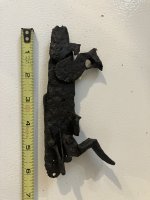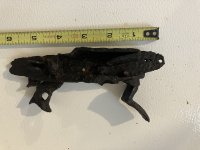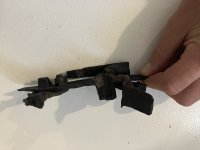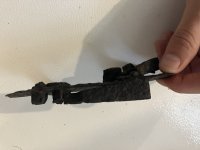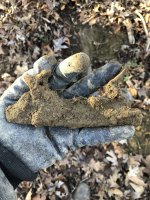Dug this ~ 3 years ago near Richmond va. It is missing the top jaw, but otherwise seems to be in pretty decent shape. Any insight into maker/origin/date would be greatly appreciated.
Navigation
Install the app
How to install the app on iOS
Follow along with the video below to see how to install our site as a web app on your home screen.
Note: This feature may not be available in some browsers.
More options
You are using an out of date browser. It may not display this or other websites correctly.
You should upgrade or use an alternative browser.
You should upgrade or use an alternative browser.
✅ SOLVED Flintlock plate
- Thread starter ncsuwolf
- Start date
Solution
The hammer is of the 'double-neck' type used by the French, rather than the 'gooseneck' style used by the British. French and French style muskets would have been uncommon in Virginia before 1777, but after that became the type most used by American forces during the revolution. Double-necked hammers were also used on US -produced military muskets from 1795 until the end of production about 1841.
- Jun 8, 2006
- 6,212
- 8,693
- Detector(s) used
- Whites, Minelab, Tesoro, and custom machines
- Primary Interest:
- Metal Detecting
It's a flintlock In the first pic you have the frizzen on the bottom. Great find!!Dug this ~ 3 years ago near Richmond va. It is missing the top jaw, but otherwise seems to be in pretty decent shape. Any insight into maker/origin/date would be greatly appreciated.
Upvote
1
The hammer is of the 'double-neck' type used by the French, rather than the 'gooseneck' style used by the British. French and French style muskets would have been uncommon in Virginia before 1777, but after that became the type most used by American forces during the revolution. Double-necked hammers were also used on US -produced military muskets from 1795 until the end of production about 1841.
Upvote
6
Solution
- Thread starter
- #6
Thank you very much for the insight. You may be more correct than you know….i am in the middle of one of the original Huguenot settlements (churches dating to the mid/late 1600s). French actually makes sense for here.The hammer is of the 'double-neck' type used by the French, rather than the 'gooseneck' style used by the British. French and French style muskets would have been uncommon in Virginia before 1777, but after that became the type most used by American forces during the revolution. Double-necked hammers were also used on US -produced military muskets from 1795 until the end of production about 1841.
Upvote
3
- Thread starter
- #7
The hammer is of the 'double-neck' type used by the French, rather than the 'gooseneck' style used by the British. French and French style muskets would have been uncommon in Virginia before 1777, but after that became the type most used by American forces during the revolution. Double-necked hammers were also used on US -produced military muskets from 1795 until the end of production about
For additional info, it was found in what I think was a blacksmith shop. So assuming this was cast aside as a transition to percussion capThank you very much for the insight. You may be more correct than you know….i am in the middle of one of the original Huguenot settlements (churches dating to the mid/late 1600s). French actually makes sense for here.
Upvote
4
Glen's Loyalists
Jr. Member
- Jan 7, 2024
- 61
- 254
I have never heard of soaking in molasses, does that work? Are there any advantages over vinegar?Very nice. Give it an overnight soak in white vinegar or molasses to remove some of the crud.
Upvote
0
- May 9, 2012
- 23,392
- 77,575
- Primary Interest:
- Other
Respectfully folks... The lock pictured appears to be a Doglock.
Look closely in the first picture with the vertical tape measure with it's end at the rear of the hammer, for the pivoting dog/ hook..
Doglocks predated flintlocks which predated percussion.
(Dog lock is a flintlock but before common flintlocks..)
Don't hold me to it , but a doglock in the early to mid 1600's would fit just right in a crowd back then. And fits the context of the recovery site very well.
Look closely in the first picture with the vertical tape measure with it's end at the rear of the hammer, for the pivoting dog/ hook..
Doglocks predated flintlocks which predated percussion.
(Dog lock is a flintlock but before common flintlocks..)
Don't hold me to it , but a doglock in the early to mid 1600's would fit just right in a crowd back then. And fits the context of the recovery site very well.
Upvote
3
- Thread starter
- #10
Respectfully folks... The lock pictured appears to be a Doglock.
Look closely in the first picture with the vertical tape measure with it's end at the rear of the hammer, for the pivoting dog/ hook..
Doglocks predated flintlocks which predated percussion.
(Dog lock is a flintlock but before common flintlocks..)
Don't hold me to it , but a doglock in the early to mid 1600's would fit just right in a crowd back then. And fits the context of the recovery site very well.
Thank you for the input. This area has settlements dating to mid 1600s, so not out of realm of possibility.Respectfully folks... The lock pictured appears to be a Doglock.
Look closely in the first picture with the vertical tape measure with it's end at the rear of the hammer, for the pivoting dog/ hook..
Doglocks predated flintlocks which predated percussion.
(Dog lock is a flintlock but before common flintlocks..)
Don't hold me to it , but a doglock in the early to mid 1600's would fit just right in a crowd back then. And fits the context of the recovery site very well.
Upvote
3
- Feb 3, 2009
- 39,937
- 151,627
- 🥇 Banner finds
- 1
- Detector(s) used
- Deus, Deus 2, Minelab 3030, E-Trac,
- Primary Interest:
- Relic Hunting
In some restoration molasses is used as it's just not as aggressive.I have never heard of soaking in molasses, does that work? Are there any advantages over vinegar?
Upvote
2
Top Member Reactions
-
 3613
3613 -
 2006
2006 -
 1785
1785 -
 1454
1454 -
 1232
1232 -
 1175
1175 -
 1076
1076 -
 966
966 -
 838
838 -
 733
733 -
 638
638 -
 577
577 -
 483
483 -
 477
477 -
 461
461 -
E
433
-
 391
391 -
 390
390 -
 384
384 -
 356
356
Users who are viewing this thread
Total: 2 (members: 0, guests: 2)


